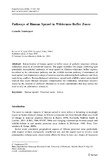| dc.contributor.author | Vanderpost, C. | |
| dc.date.accessioned | 2013-12-06T06:38:06Z | |
| dc.date.available | 2013-12-06T06:38:06Z | |
| dc.date.issued | 2006 | |
| dc.identifier.citation | Vanderpost, C. (2006) Pathways of human sprawl in wilderness buffer zones, Population and Environment, vol. 27 no. 3, pp. 285-306. | en_US |
| dc.identifier.uri | http://hdl.handle.net/10311/1189 | |
| dc.description.abstract | Intensification of human sprawl in buffer zones of globally important African wilderness areas is of worldwide concern. The paper identifies two major conflicting (yet potentially reconcilable) pathways of rural sprawl in African wilderness buffer regions, described as the subsistence pathway and the wildlife-tourism pathway. Containment of
rural sprawl near important ecological reserves requires addressing both pathways and their underlying conflicts. Reconciliation of subsistence sprawl with wildlife-conservation based
tourism may occur through adequate compensation for community subsistence resource
losses by the creation of sufficient alternatives to local communities that may reduce the
need to rely on subsistence resources. | en_US |
| dc.language.iso | en | en_US |
| dc.publisher | Springer, http://www.springer.com | en_US |
| dc.subject | Human sprawls | en_US |
| dc.subject | Protected areas | en_US |
| dc.title | Pathways of human sprawl in wilderness buffer zones | en_US |
| dc.type | Published Article | en_US |
| dc.link | http://link.springer.com/article/10.1007/s11111-006-0022-5#page-1 | en_US |

